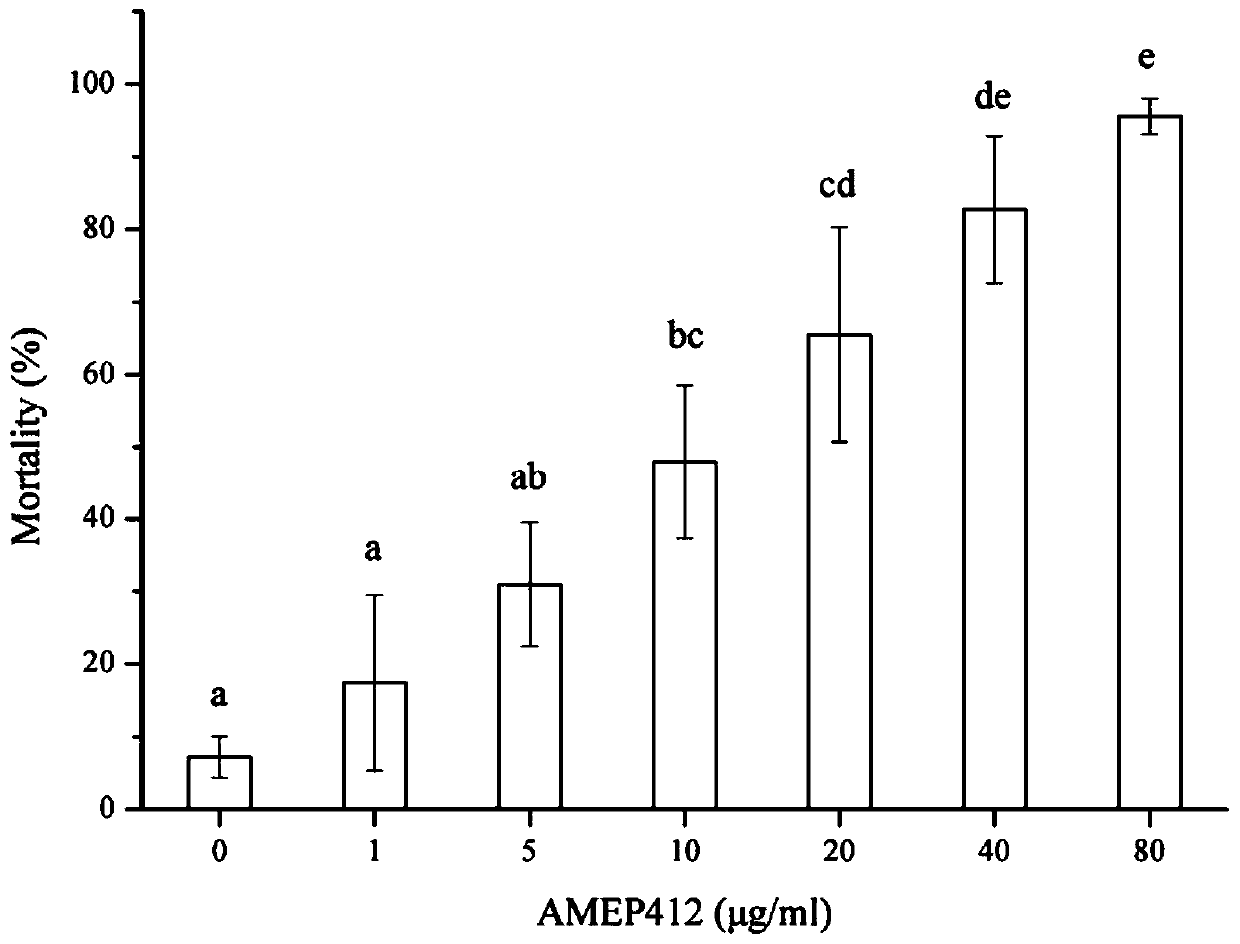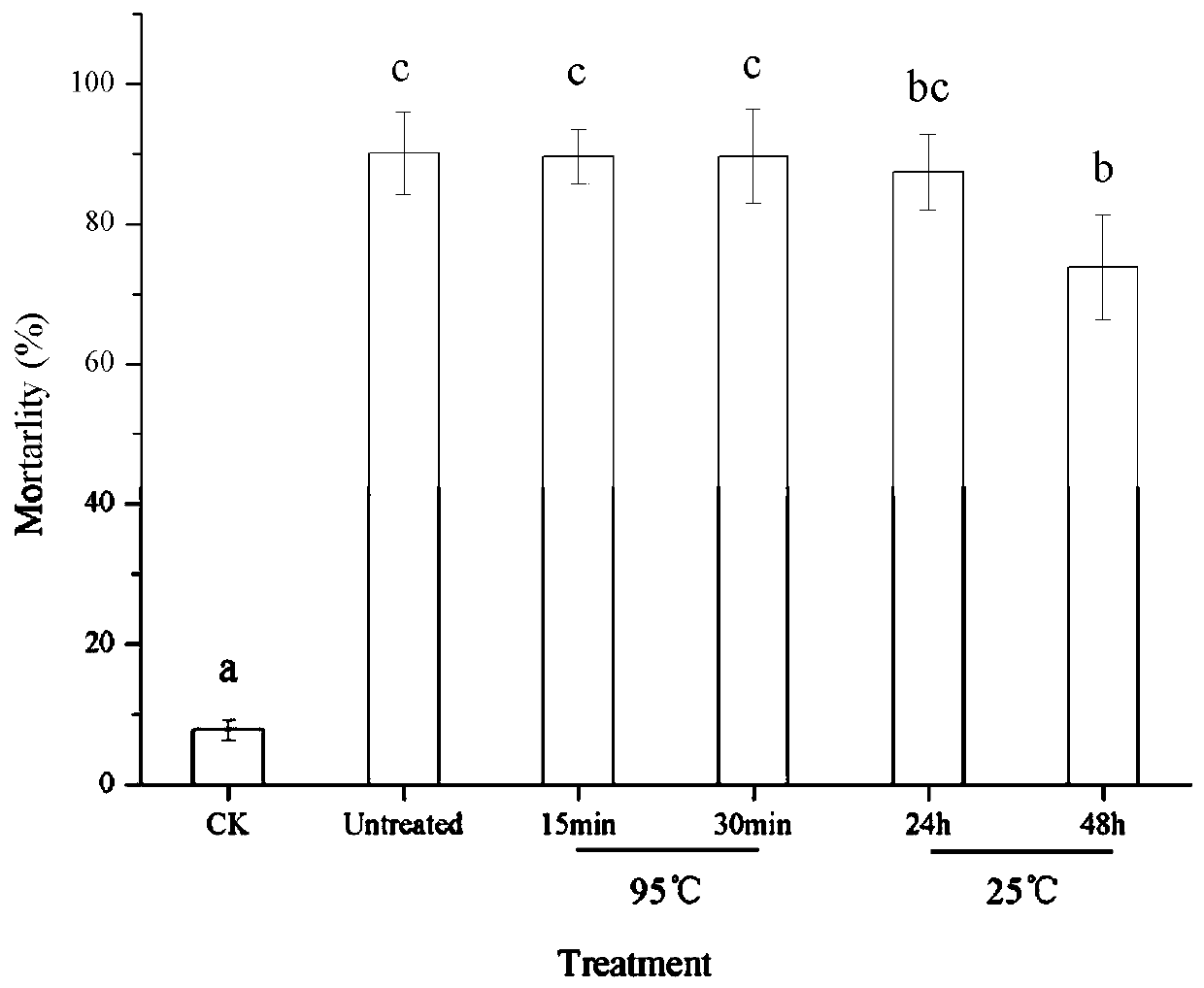Insecticidal activity of AMEP412 protein on trialeurodes vaporariorum and application of AMEP412 protein in prevention and treatment of trialeurodes vaporariorum
A whitefly and protein technology, applied in the application, insecticide, biocide and other directions, can solve the problem of low insecticidal protein in whitefly and achieve good control effect.
- Summary
- Abstract
- Description
- Claims
- Application Information
AI Technical Summary
Problems solved by technology
Method used
Image
Examples
Embodiment 1
[0023] This example illustrates the insecticidal effect of Bacillus subtilis AMEP412 protein artificially fed to whitefly.
[0024] The liquid artificial bait for feeding is sterilized by dissolving 5% yeast extract and 30% sucrose in distilled water, adding different concentrations of AMEP412 (1, 5, 10, 20, 40 and 80 μg / ml), and mixing for later use. The artificial bait without AMEP412 was used as the control. The 1-2 day-old whitefly adults are driven from the plant leaves into 50ml test tubes, and at least 50 whitefly adults are taken in each test tube. Cover the test tube cap with two layers of stretched parafilm, add bait (100 μl) between the two layers of film, and then cover the tube cap in reverse, so that the double film structure remains on the inside of the test tube and upwards. Place vertically. Each experiment was repeated three times. Mortality was measured 2 days after feeding, and mortality was recorded by counting dead whitefly adults at the bottom of the ...
Embodiment 2
[0029] This example illustrates the stability test of Bacillus subtilis AMEP412 protein.
[0030] In order to test the heat resistance of AMEP412 protein, protein samples were treated at 95°C for 15 minutes and 30 minutes, respectively. The cooled protein sample was prepared as artificial bait according to the method in Example 1, and the final concentration was adjusted to 60 μg / ml to test the insecticidal effect on whitefly. Each treatment was repeated three times with untreated protein samples as controls. In order to test the stability of AMEP412 protein against natural degradation, protein samples were placed in 1.5ml centrifuge tubes at room temperature 25°C for 24 hours and 48 hours respectively. Afterwards, artificial bait was prepared from the protein sample according to the method in Example 1, and the final concentration was adjusted to 60 μg / ml to test the insecticidal effect of whitefly. Each treatment was repeated three times with untreated protein samples as c...
Embodiment 3
[0033] This example illustrates the fluorescent localization of Bacillus subtilis AMEP412 protein in whitefly.
[0034]The AMEP412 protein was incubated with fluorescein FITC, and the FITC not bound to the AMEP412 protein was removed by molecular sieve chromatography according to the difference in molecular volume to obtain FITC-labeled AMEP412 protein. The FITC-labeled AMEP412 protein was subsequently fed to whitefly adults. The dead whitefly adults were washed with distilled water, and then the Olympus BX60 fluorescence microscope was used to excite green fluorescence at a wavelength of 495 nm for fluorescence microscopic observation. The results show( image 3 ), the green fluorescence is concentrated in the intestine of the abdominal cavity of whitefly adults, indicating that AMEP412 protein can be taken into the body of whitefly adults and localized in the intestine. This result suggests that AMEP412 plays an insecticidal role in the intestinal tract.
PUM
 Login to View More
Login to View More Abstract
Description
Claims
Application Information
 Login to View More
Login to View More - R&D
- Intellectual Property
- Life Sciences
- Materials
- Tech Scout
- Unparalleled Data Quality
- Higher Quality Content
- 60% Fewer Hallucinations
Browse by: Latest US Patents, China's latest patents, Technical Efficacy Thesaurus, Application Domain, Technology Topic, Popular Technical Reports.
© 2025 PatSnap. All rights reserved.Legal|Privacy policy|Modern Slavery Act Transparency Statement|Sitemap|About US| Contact US: help@patsnap.com



